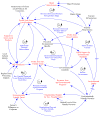Conceptual modeling for adaptive environmental assessment and management in the Barycz Valley, lower Silesia, Poland
- PMID: 16705818
- PMCID: PMC3810621
- DOI: 10.3390/ijerph2005020001
Conceptual modeling for adaptive environmental assessment and management in the Barycz Valley, lower Silesia, Poland
Abstract
The complexity of interactions in socio-ecological systems makes it very difficult to plan and implement policies successfully. Traditional environmental management and assessment techniques produce unsatisfactory results because they often ignore facets of system structure that underlie complexity: delays, feedbacks, and non-linearities. Assuming that causes are linked in a linear chain, they concentrate on technological developments ("hard path") as the only solutions to environmental problems. Adaptive Management is recognized as a promising alternative approach directly addressing links between social and ecological systems and involving stakeholders in the analysis and decision process. This "soft path" requires special tools to facilitate collaboration between "experts" and stakeholders in analyzing complex situations and prioritizing policies and actions. We have applied conceptual modeling to increase communication, understanding and commitment in the project of seven NGOs "Sustainable Regional Development in the Odra Catchment". The main goal was to help our NGO partners to facilitate their efforts related to developing sustainable policies and practices to respond to large-scale challenges (EU accession, global changes in climate and economy) to their natural, economic and socio-cultural heritages. Among the variety of sustainability issues explored by these NGOs, two (extensive agricultural practices and "green" local products) were examined by using Adaptive Management (AM) as a framework that would link analysis, discussion, research, actions and monitoring. Within the AM framework the project coordinators used tools of systems analysis (Mental Model Mapping) to facilitate discussions in which NGO professionals and local stakeholders could graphically diagram and study their understanding of what factors interacted and how they affect the region's sustainability. These discussions produced larger-scale Regional Sustainability Models as well as more detailed sub-models of particular factors, processes, and feedback loops that appear critical to a sustainable future. The Regional Sustainability Model was used to identify a subset of key interacting factors (variables). For each variable, several sustainability indicators were suggested. The growing understanding and acceptance of the AM framework and systems analysis created a momentum both locally and within the region, which makes continued successful use of these indicators quite likely. In contrast to expert-driven projects that inject outside knowledge into a local context, this project established a broad basis for stakeholder-driven discussion that is articulated into goals, objectives, conceptual models, and indicators. The ability to learn and adapt in the AM framework increases the capacity to innovate and find policies and practices that enhance resilience and sustainability in a world in transition.
Figures




References
-
- Sterman J. Business Dynamics: Systems Thinking and Modeling for a Complex World. Irwin/McGraw-Hill; New York: 2000.
-
- Sterman J. Syst. Dyn. Rev. 2002;18:501–531.
-
- Rittel H., Webber M. Policy Sciences. 1973;4:155–159.
-
- Gleick P. H. Science. 2003;302(5650):1524–1528. - PubMed
-
- Holling C. S., editor. Adaptive environmental assessment and management. John Wiley; New York: 1978.
Publication types
MeSH terms
LinkOut - more resources
Full Text Sources
